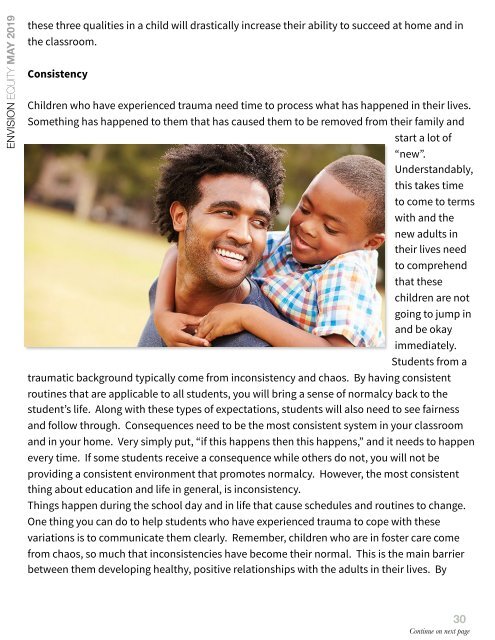May 2019 Foster Care Special Edition
You also want an ePaper? Increase the reach of your titles
YUMPU automatically turns print PDFs into web optimized ePapers that Google loves.
ENVISION EQUITY MAY <strong>2019</strong><br />
these three qualities in a child will drastically increase their ability to succeed at home and in<br />
the classroom.<br />
Consistency<br />
Children who have experienced trauma need time to process what has happened in their lives.<br />
Something has happened to them that has caused them to be removed from their family and<br />
start a lot of<br />
“new”.<br />
Understandably,<br />
this takes time<br />
to come to terms<br />
with and the<br />
new adults in<br />
their lives need<br />
to comprehend<br />
that these<br />
children are not<br />
going to jump in<br />
and be okay<br />
immediately.<br />
Students from a<br />
traumatic background typically come from inconsistency and chaos. By having consistent<br />
routines that are applicable to all students, you will bring a sense of normalcy back to the<br />
student’s life. Along with these types of expectations, students will also need to see fairness<br />
and follow through. Consequences need to be the most consistent system in your classroom<br />
and in your home. Very simply put, “if this happens then this happens,” and it needs to happen<br />
every time. If some students receive a consequence while others do not, you will not be<br />
providing a consistent environment that promotes normalcy. However, the most consistent<br />
thing about education and life in general, is inconsistency.<br />
Things happen during the school day and in life that cause schedules and routines to change.<br />
One thing you can do to help students who have experienced trauma to cope with these<br />
variations is to communicate them clearly. Remember, children who are in foster care come<br />
from chaos, so much that inconsistencies have become their normal. This is the main barrier<br />
between them developing healthy, positive relationships with the adults in their lives. By<br />
30<br />
Continue on next page

















